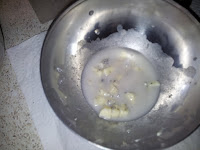Cheese Glue
Participants: Alex, Georgia,
Fiona, Clare
Items: Milk as two forms of
cheese and milk
Original Recipe
Cennini - To Make a Glue out
of Lime and Cheese.
Chapter CXII
Ends the Fifth Section of
this Book
There is a glue used by
workers in wood; this is made of cheese. After putting it to soak in water,
work it over with a little quicklime, using a little board with both hands. Put
it between the boards; it joins them and fastens them together well. And let
this suffice you for the making of various kinds of glue.
Redaction
Firstly this recipe does not
specify the type of cheese to use, soft, semi-soft or hard. So this needs to be
attempted with all types of the cheese to test for the most appropriate type.
Attempts using different
quantities of water (ie think/thin mixtures) will be needed as well.
Ingredients
Cheese, quicklime, water,
milk.
Method
Soak cheese in water (until
soft?)
Mix quicklime (be careful as
this will release heat) using boards (not your hands)
Mix in a little milk if it
is too thick.
Put mixture between boards
to set.
Our Process
Cheese
One attempt at an Asiago
cheese has failed. I will use to good parts of the cheese as the hard cheese
attempt for this recipe.
I have also made some quark
which is a soft cheese. I will use this as the soft cheese attempt.
As I am unable to make
semi-soft cheeses (I have no way to control humidity accurately enough) I will
buy some cheap camembert or brie for the semi-soft attempt. [We never got to this part!!]
Making Quicklime
Lime can come from limestone
or from sea shells.
Method:
Heat the lime to red hot for
a minimum of 3 minutes.
Our Process:
Attempt 1: We attempted to
make quicklime using limestone from a paver. We had two different types of
limestone paver, a light coloured one called 'natural' and a darker coloured
one called 'honey limestone'.
These paver also had
different striations and shattered differently. We broke these into manageable
pieces and filled two crucibles with them (Hulk, smash!).
We then used the furnace to bake the limestone.
Firstly lighting the fire in the furnace from char cloth!
Unfortunately the provider
of the furnace (Master Owen) was a little over zealous with the time taken to
heat up the crucibles and they both cracked. Which you can see in the pictures.
This doesn't seem to have
worked mostly, we believe, because it was possibly reconstituted limestone and
may have had other additives which inhibited the process.
Breaking up the pavers - Starting the furnace - getting the pavers hot
Crucibles heating up - testing for quicklime
Attempt 2: Next attempt will
be sea shells.
We heated the shells red hot for about 5 minutes using a gas torch. This seems to have worked, creating a small amount of quicklime.



Shell grit - heating shell grit with the gas torch - quicklime!
Final Product:
We made the quicklime in the
evening and let it soak overnight to create a lime water. We then used this
lime water, mixed with the cheese, to make a glue solution.
Making the lime water - asiago mix - quark mix
Bits of wood stuck together - samples for display/final entry
Final Entry
Notes:
- We tried two sets of quicklime with only one working. I will know better for next time what to look for in regards to colour changes (red hot and white hot) as well as products to use. Don't use pavers!
- The asiago was a complete fail. The intent of the recipe is to use the glue straight away and this cheese (and probably any hard cheese) will take too much time to soften sufficiently in the implied timeframe.
- Quark makes pretty awesome looking glue. Not sure of its effectiveness as yet, but good start. It has the consistency of Aquahere, which is good.
- It was very fun to have tried the furnace approach and starting it from char cloth and steel.
- Don't eat the paste....
Additional Notes after the fact:
- The glue held really well. I needed a hammer to separate the two bits of wood I had glued together.










